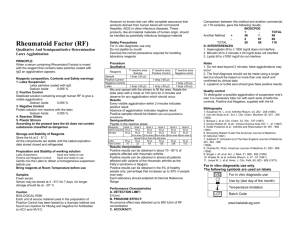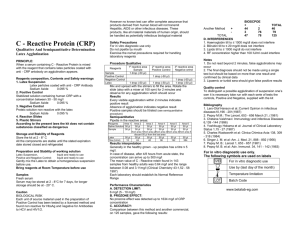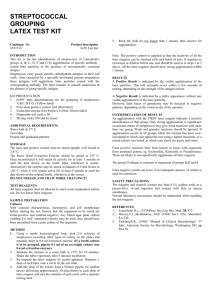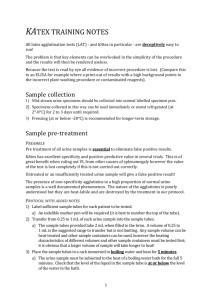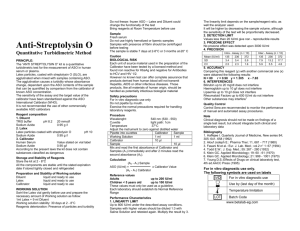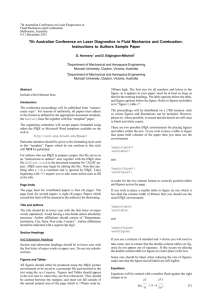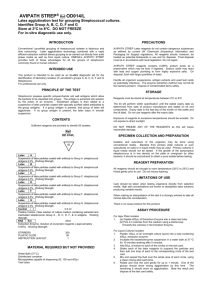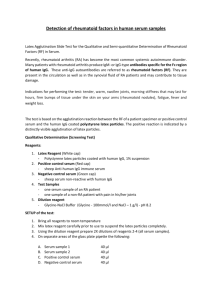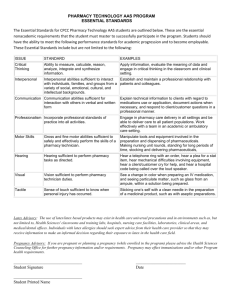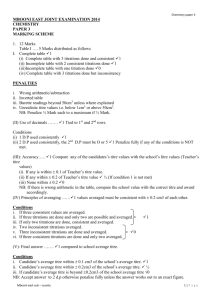Anti O-Streptolysin (ASO)
advertisement
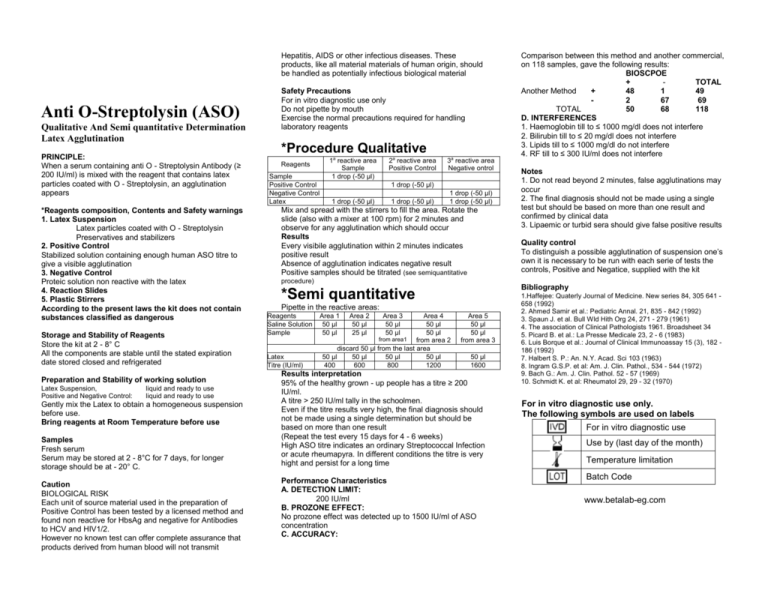
Hepatitis, AIDS or other infectious diseases. These products, like all material materials of human origin, should be handled as potentially infectious biological material Anti O-Streptolysin (ASO) Qualitative And Semi quantitative Determination Latex Agglutination PRINCIPLE: When a serum containing anti O - Streptolysin Antibody (≥ 200 IU/ml) is mixed with the reagent that contains latex particles coated with O - Streptolysin, an agglutination appears *Reagents composition, Contents and Safety warnings 1. Latex Suspension Latex particles coated with O - Streptolysin Preservatives and stabilizers 2. Positive Control Stabilized solution containing enough human ASO titre to give a visible agglutination 3. Negative Control Proteic solution non reactive with the latex 4. Reaction Slides 5. Plastic Stirrers According to the present laws the kit does not contain substances classified as dangerous Storage and Stability of Reagents Store the kit at 2 - 8° C All the components are stable until the stated expiration date stored closed and refrigerated Preparation and Stability of working solution Latex Suspension, Positive and Negative Control: liquid and ready to use liquid and ready to use Gently mix the Latex to obtain a homogeneous suspension before use. Bring reagents at Room Temperature before use Samples Fresh serum Serum may be stored at 2 - 8°C for 7 days, for longer storage should be at - 20° C. Caution BIOLOGICAL RISK Each unit of source material used in the preparation of Positive Control has been tested by a licensed method and found non reactive for HbsAg and negative for Antibodies to HCV and HIV1/2. However no known test can offer complete assurance that products derived from human blood will not transmit Safety Precautions For in vitro diagnostic use only Do not pipette by mouth Exercise the normal precautions required for handling laboratory reagents *Procedure Qualitative Reagents Sample Positive Control Negative Control Latex 1a reactive area Sample 1 drop (-50 μl) 2a reactive area Positive Control 3a reactive area Negative ontrol 1 drop (-50 μl) 1 drop (-50 μl) 1 drop (-50 μl) 1 drop (-50 μl) 1 drop (-50 μl) Mix and spread with the stirrers to fill the area. Rotate the slide (also with a mixer at 100 rpm) for 2 minutes and observe for any agglutination which should occur Results Every visibile agglutination within 2 minutes indicates positive result Absence of agglutination indicates negative result Positive samples should be titrated (see semiquantitative procedure) Pipette in the reactive areas: Latex Titre (IU/ml) Area 1 50 μl 50 μl Area 2 50 μl 25 μl Area 3 50 μl 50 μl Area 4 50 μl 50 μl from area1 from area 2 discard 50 μl from the last area 50 μl 50 μl 50 μl 50 μl 400 600 800 1200 Notes 1. Do not read beyond 2 minutes, false agglutinations may occur 2. The final diagnosis should not be made using a single test but should be based on more than one result and confirmed by clinical data 3. Lipaemic or turbid sera should give false positive results Quality control To distinguish a possible agglutination of suspension one’s own it is necessary to be run with each serie of tests the controls, Positive and Negatice, supplied with the kit Bibliography *Semi quantitative Reagents Saline Solution Sample Comparison between this method and another commercial, on 118 samples, gave the following results: BIOSCPOE + TOTAL Another Method + 48 1 49 2 67 69 TOTAL 50 68 118 D. INTERFERENCES 1. Haemoglobin till to ≤ 1000 mg/dl does not interfere 2. Bilirubin till to ≤ 20 mg/dl does not interfere 3. Lipids till to ≤ 1000 mg/dl do not interfere 4. RF till to ≤ 300 IU/ml does not interfere Area 5 50 μl 50 μl from area 3 50 μl 1600 Results interpretation 95% of the healthy grown - up people has a titre ≥ 200 IU/ml. A titre > 250 IU/ml tally in the schoolmen. Even if the titre results very high, the final diagnosis should not be made using a single determination but should be based on more than one result (Repeat the test every 15 days for 4 - 6 weeks) High ASO titre indicates an ordinary Streptococcal Infection or acute rheumapyra. In different conditions the titre is very hight and persist for a long time Performance Characteristics A. DETECTION LIMIT: 200 IU/ml B. PROZONE EFFECT: No prozone effect was detected up to 1500 IU/ml of ASO concentration C. ACCURACY: 1.Haffejee: Quaterly Journal of Medicine. New series 84, 305 641 658 (1992) 2. Ahmed Samir et al.: Pediatric Annal. 21, 835 - 842 (1992) 3. Spaun J. et al. Bull Wld Hith Org 24, 271 - 279 (1961) 4. The association of Clinical Pathologists 1961. Broadsheet 34 5. Picard B. et al.: La Presse Medicale 23, 2 - 6 (1983) 6. Luis Borque et al.: Journal of Clinical Immunoassay 15 (3), 182 186 (1992) 7. Halbert S. P.: An. N.Y. Acad. Sci 103 (1963) 8. Ingram G.S.P. et al: Am. J. Clin. Pathol., 534 - 544 (1972) 9. Bach G.: Am. J. Clin. Pathol. 52 - 57 (1969) 10. Schmidt K. et al: Rheumatol 29, 29 - 32 (1970) For in vitro diagnostic use only. The following symbols are used on labels For in vitro diagnostic use Use by (last day of the month) Temperature limitation Batch Code www.betalab-eg.com
